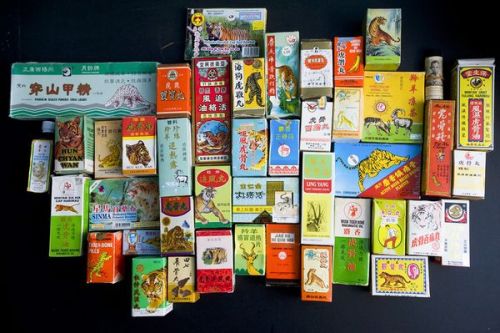Tigers in Traditional Chinese Medicine For more than 1000 years the use of tiger parts has been incl
Tigers in Traditional Chinese Medicine For more than 1000 years the use of tiger parts has been included in the traditional Chinese medicine regimen. Because of the tiger’s strength and mythical power, the Chinese culture believes that the tiger has medicinal qualities, which helps treat chronic ailments, cure disease and replenish the body’s essential energy. Traditionally, most tiger parts were considered to have a healing effect on human beings. Whiskers for tooth ache Teeth for rabies, asthma, and sores on penis Eyeballs for epilepsy and malaria Biles for convulsions in children Brain to cure laziness and pimples Blood for strengthening the constitution and will power Skin to treat mental illness Fat for vomiting, dog bites, bleeding, and haemmorrhoids Tail for various skin diseases Claws for insomnia Bone for rheumatism, arthritis, general weakness, headaches, stiffness or paralysis primarily in lower back and legs, and dysentery Despite scientific proof that tend to discount all claims of any curative power in tiger bones, Chinese medicine stores in Hong Kong, China, Taiwan, South Korea, Vietnam and in Chinatowns across Europe and North America, do a steady trade in tiger wines, powder, tiger balms and tiger pills. Many Asian communities believe that tiger bone, in powdered form or prepared as tiger wine, soothes rheumatic pain and cures ulcers, malaria and burns. Although the use of tiger bones was removed from the traditional Chinese medicine (TCM) pharmacopeia in 1993, when China first introduced a domestic ban on tiger trade, the increase in the standard of living in southeast Asia has made these remedies available to most people. It is no wonder then that this newly affluent population has had a great effect on wildlife numbers and the demand for tiger parts. In many places in China, tiger parts are a delicacy that is served at special private banquets. The use of endangered tiger products and their medicines is seen as a symbol of high status and wealth. Some remedies list tiger parts as an ingredient, but the real animal parts are so expensive that often the medicines may have only trace elements; but even this is enough to promote the continued slaughter of the tiger. Further reading: On Tiger Balm (which contains no tiger parts) here, on recent sales of tiger bone wine on auction, an 15 years old undercover discovery of sales of tiger parts in American Chinatowns and finally a general introduction to the issue. -- source link
Tumblr Blog : matteoricci.tumblr.com
#chinese tiger#tiger parts#tiger bones#endangered animals#tiger wine

